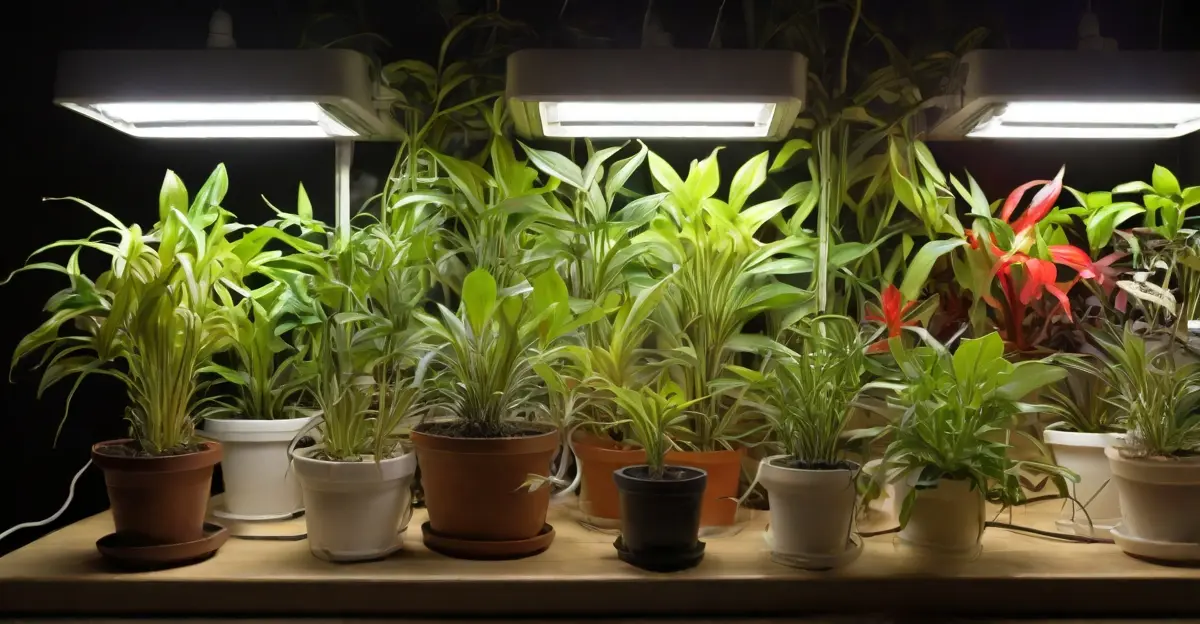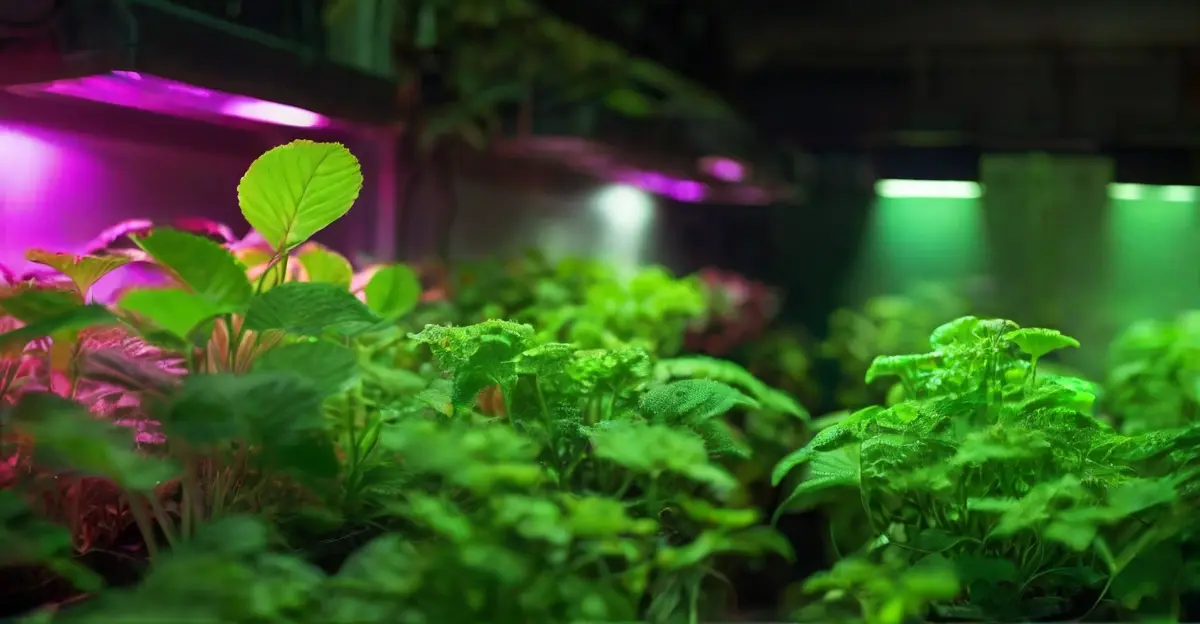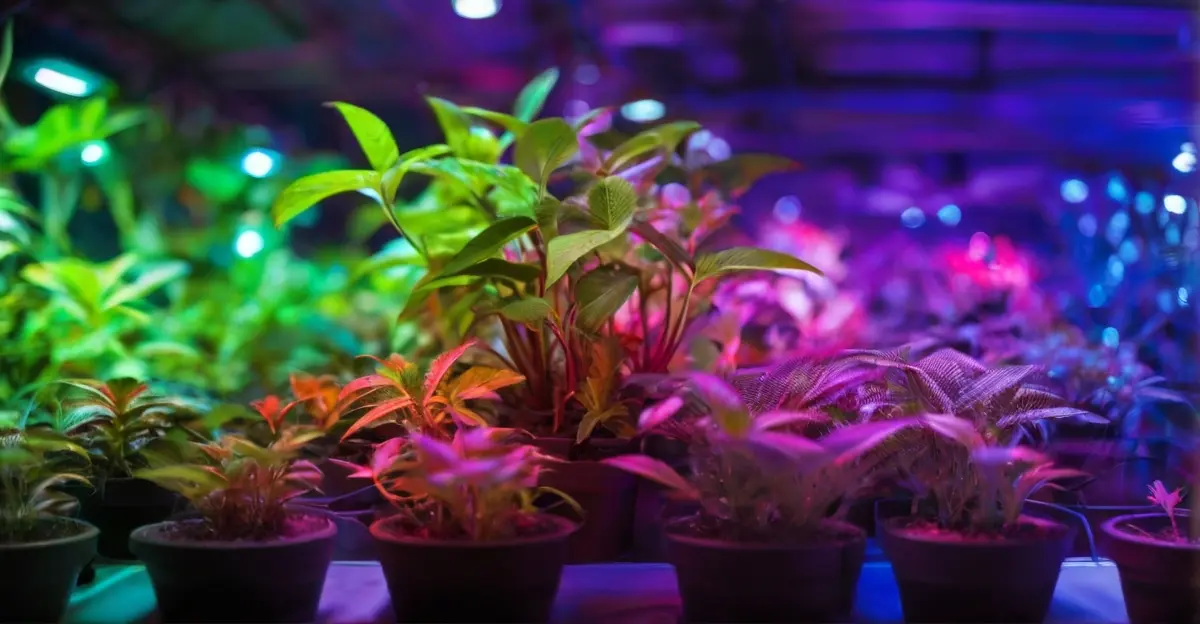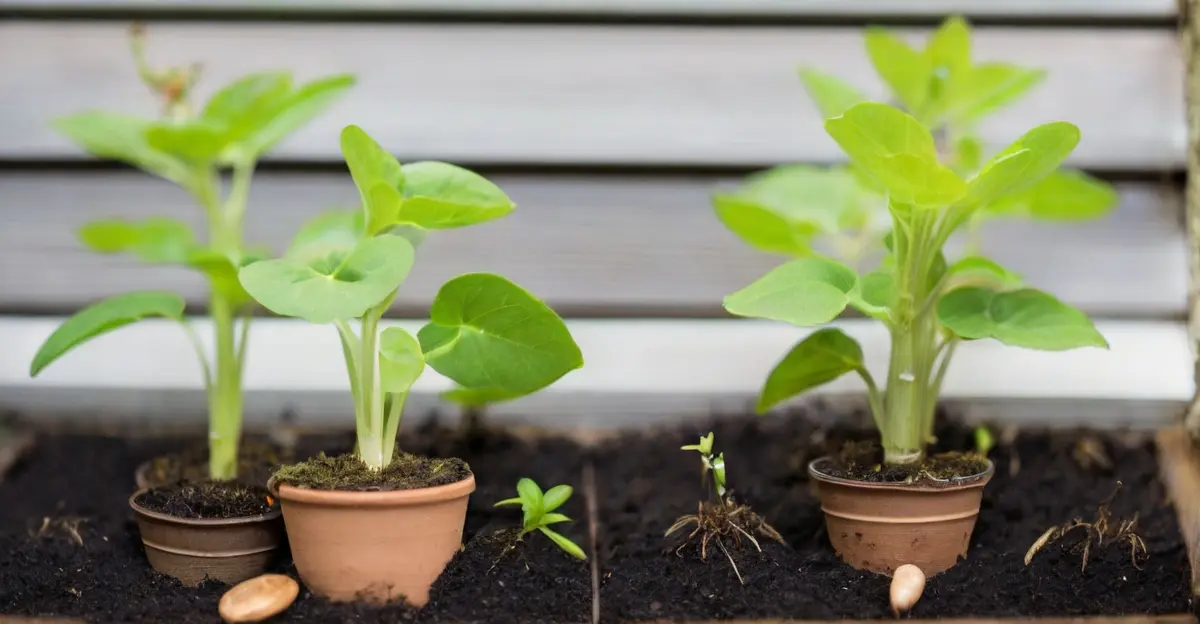What Color Light Is Best for Plant Growth (2024 Guide)

NIH research reveals that using supplemental red or yellow LED lights for 4 hours per day increased carotenoid levels in cucumber seedlings by 100%.
By amplifying the precise wavelengths plants absorb for photosynthesis, flowering, and fruiting, you can unlock the greatest genetic potential of your plants.
But does more red light always equate to bigger, better plants?
What about blue or even green wavelengths?
Read on as we deliver actionable insights for setting up photon-perfect indoor gardens tailored to your crops.
TL;DR Summary
Why Does Light Color Matter for Plant Growth?
Plants have evolved over billions of years to capture sunlight and utilize it to power their growth expertly.
But why do different light colors affect them differently?
The answer lies in photosynthesis and the varying pigments that absorb specific wavelengths.
When light strikes a plant’s surface, specialized pigment molecules like chlorophyll and carotenoids absorb distinct parts of the visible spectrum.
Here’s the deal:
- Without blue photons, plants cannot open stomata pores to uptake enough carbon dioxide (source).
- Minus adequate red spectra, plants cannot drive photosynthesis fast enough (source).
- With insufficient green light penetration deep into leaves, overall carbohydrate supplies run low (source).
Balancing these light colors ensures optimal photosynthetic output to create compounds necessary for vigorous plant growth.
Too much or too little of any portion of the light spectrum creates bottlenecks in this manufacturing pipeline.
So, in short, plants are light-powered biochemical factories.
And their productivity relies on receiving just the right ingredients in the form of color-coded photons.
With that out of the way, let’s get into specific visible and invisible light color spectrums and their effects on plant growth.
Purple-Blue Wavelengths (400-500 nm)

Grow lights that emit purple and blue light wavelengths ranging from 400-500 nm are commonly used in indoor gardening to stimulate healthy plant growth.
Exposure to blue photons in the 400-500 nm range influences key operations like:
One study found that high-intensity blue light-induced chloroplast avoidance movement in Arabidopsis could potentially impact leaf thickness.
However, blue light alone cannot optimize plant growth.
Red light ranging from 600-700 nm also plays a crucial photosynthetic role in water splitting, enzyme regulation, and carbohydrate production.
Thus, most horticultural lighting solutions leverage tuneable full-spectrum LEDs producing both blue and red light.
For full spectrum coverage, experts recommend pairing purple-blue LEDs with red lighting (80-90% red, 10-20% blue) to optimize plant growth.
NOTE: There is no universally ideal red:blue ratio. The optimal ratio depends on the specific plant variety and growth stage.
Green Wavelengths (500-600 nm)

Exposure to green light plays a valuable role in healthy plant growth and development.
Green wavelengths, ranging from 500-600 nm, penetrate deeper into thick plant canopies due to weaker absorption compared to blue or red peaks.
Without enough green light reaching lower foliage, overall yields may suffer.
Multiple studies found that adding a small amount of green light (10-24%) to red and blue LED lighting improved lettuce growth compared to red/blue LED lighting alone.
Experts typically recommend that LED grow lights supply around 80% red and 20% blue light.
However, adding up to 30% green to this formula can often lead to similar or slightly better plant biomass measurements compared to red/blue alone.
Yellow and Orange Wavelengths (570-620 nm)

While less efficiently absorbed than blue or red peaks, yellow and orange wavelengths ranging from 570-620 nm can still benefit certain flowering and fruiting plants.
By stimulating carotenoid pigments, yellow and orange colors influence flavor, aroma, and aesthetic compounds (source).
Specifically, orange light (590-620 nm) and yellow light (570-590 nm) play a supporting role in processes like:
Besides boosting nutritional value, the accumulation of yellow and orange pigments acts as a visual signal of fruit ripeness.
This allows you to time your harvests for peak flavor and texture.
Specifically for flowering and fruiting plants, adding yellow or orange light to red and blue light has been shown to further improve plant quality and yield (source).
Red Wavelengths (625-740 nm)

Out of all light colors, red peaks ranging from 625-740 nm have the most profound impact on plant growth and development.
By triggering phytochromes that regulate key plant processes, red light controls everything from photosynthesis levels to the literal blooming of flowers and fruits.
Specifically, a red light wavelength of 660-680 nm allows for peak absorption by chlorophyll during photosynthesis.
Research by Michigan State University found that tomatoes grown under red LEDs containing a 660 nm peak had a 100% greater yield compared to broad-spectrum white light.
Besides sheer quantity, 660 nm deep red light drives photosynthesis and can increase biomass/yields of crops like tomatoes, cucumbers, and sweet peppers (source).
When it comes to flowering and fruiting, a supplemental blast of 660 nm red light right before harvest can optimize maturity timing and nutrient density.
Beyond the Visible: UV and Far-Red Light
“Beyond the visible” refers to non-visible wavelengths of light that still impact plant growth, including ultraviolet (UV) and far-red spectrums.
Grow lights emitting these wavelengths in moderation may provide unique benefits.
Brief UV exposure can increase disease resistance and stimulate helpful stress responses in plants.
However, overexposure causes damage, so timing is critical.
According to this study, far-red light fuels seed germination, stem elongation, and flowering, but excess tricks plants into acting shade-stunted.
Both UV and far-red light influence important plant processes when balanced properly with other wavelengths.
But improperly adjusted, they quickly become detrimental.
What About Multicolored, Broad Spectrum Plant Lights?

As discussed earlier, different light wavelengths support different plant growth processes from leaf production to flowering.
This makes tuning the spectrum vital.
Multicolored, broad-spectrum grow lights aim to cover multiple parts of the visible range, somewhat mimicking natural sunlight which provides balanced wavelengths.
They are designed to enable sufficient photosynthesis and reasonable overall development.
While broad-spectrum lighting hits major peaks, it does not optimize specific wavelengths.
So specialized full spectrum LED options now allow superior tuning to a crop’s lighting needs.
For example, one controlled environment agriculture study grew lettuce under broad spectrum white LEDs vs. narrowed red and blue spectra.
Though biomass was similar, the optimized red/blue LEDs increased anthocyanins, boosting antioxidant levels.
This shows the value of spectral control.
With LED technology advancing, you can now select lights providing a high level of customization across blue, green, yellow, red, and other wavelengths based on each plant’s photoreceptor tendencies and growth phase.
What is the Best Light Color for Optimal Plant Growth?
The Optimal Red-to-Blue Ratio
Contrary to the popular belief that “more red light equals bigger plants”, achieving peak plant productivity requires dialing into the precise percentage of red versus blue wavelengths.
Most LED grow lights supply a ratio of around 80% red and 20% blue light.
However, research shows the ideal red:blue balance depends on the plant variety and growth phase.
For example, in a study from Wageningen University, young lettuce and basil plants grew best under 90% red and 10% blue light.
Beyond fixed ratios, advanced LED lighting now enables fully customized spectrum tuning tailored to a specific crop.
The takeaway?
While red peaks drive photosynthesis and blue encourages chloroplasts and cell expansion, ensure ample amounts of both to cover all growth processes.
More Than Just Red and Blue: The Supporting Cast
Green, yellow, and other wavelengths also support balanced plant growth in specific ways:
PRO TIP: Covering 20-30% of these supporting colors fills gaps that 100% red/blue leaves open. Think of it as providing a nutrient-dense smoothie versus vitamin pills for your plants.
Full Spectrum: The Best All-Around Choice
Full-spectrum LEDs can closely mimic natural sunlight and provide a balanced spectrum for growth.
Full spectrum lighting provides balanced red and blue peaks for photosynthesis, plus supporting colors like green and yellow that encourage healthy expansion.
Tuning lighting to specific plant needs and growth stages further optimizes yields.
However, if seeking to maximize yields for fruiting veggies or flowering crops specifically, playing with customized red/blue ratios takes things up a notch!
Best Grow Light Color For Different Groups
Research shows blue light is ideal for leafy greens while a balance of blue and red works best for fruiting veggies.
Let’s break down specifics here.
For plants like lettuce, kale, and spinach, blue light in the 400-500 nm range boosts expansive leaf growth by activating helpful photoreceptor molecules (source).
Aim for LED grow lights with a color temperature of 5000-6500K to cover the blue light “sweet spot” for leafy greens.
Match this with adequate intensity – green leafies need higher moderate light intensities of 170-300 μmol/m2/s.
Moreover, warm white light heavier on red/yellow wavelengths supports fruit and flower production in plants like tomatoes, peppers, and eggplants (source).
Look for a warmer 3000-4000K color temp in LED grow lights to cover ample red spectra for fruiters, along with at least 20% blue light. And don’t skimp on intensity – aim for 300-600 μmol/m2/s.
In general: full-spectrum white LED lights with both blue and red are ideal for healthy growth from seedling to harvest.
Ideal Grow Light Color for Seedlings vs. Mature Plants

When it comes to plant growth lighting, seedlings and mature plants have differing needs.
For seedlings:
For mature plants:
Don’t hesitate to shift from vegetative to flowering stage formulations as plants mature.
Achieving Maximum Indoor Plant Growth Potential
Optimizing indoor plant growth comes down to understanding and harnessing the power of light.
To recap:
Different colored lights help plants in different ways.
Blue light grows leaves. Red light grows flowers and fruits.
Green and other colors also help.
Special LED lights now let you choose the perfect color mix for your plants. This helps them grow their best.
Pick lights that match what your plants need. Change the color as they grow.
Use blue light for young seedlings. Use more red light when plants are older.
Always give plants a rainbow of light for awesome results!
FURTHER READING: What Color Light Is Worst for Plant Growth (2024 Updated)
Meet your guide
Dhruvir Zala